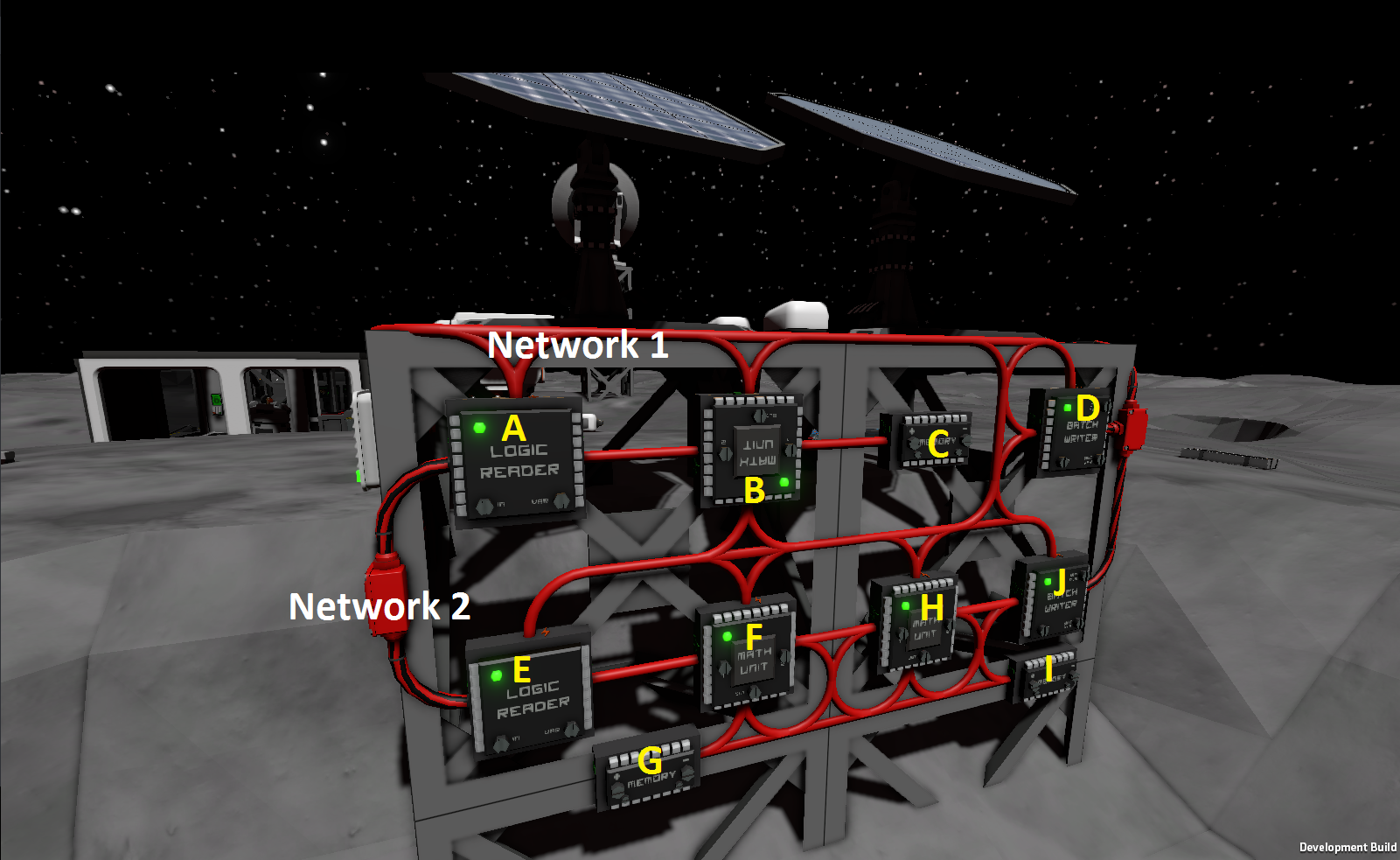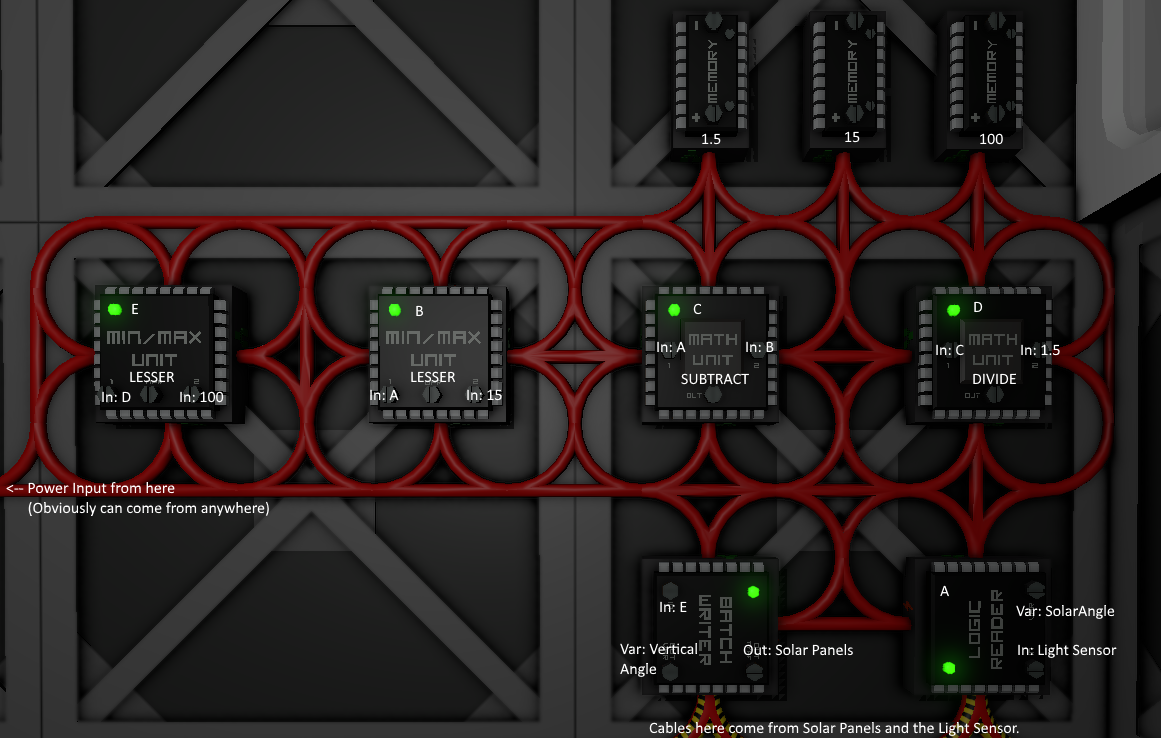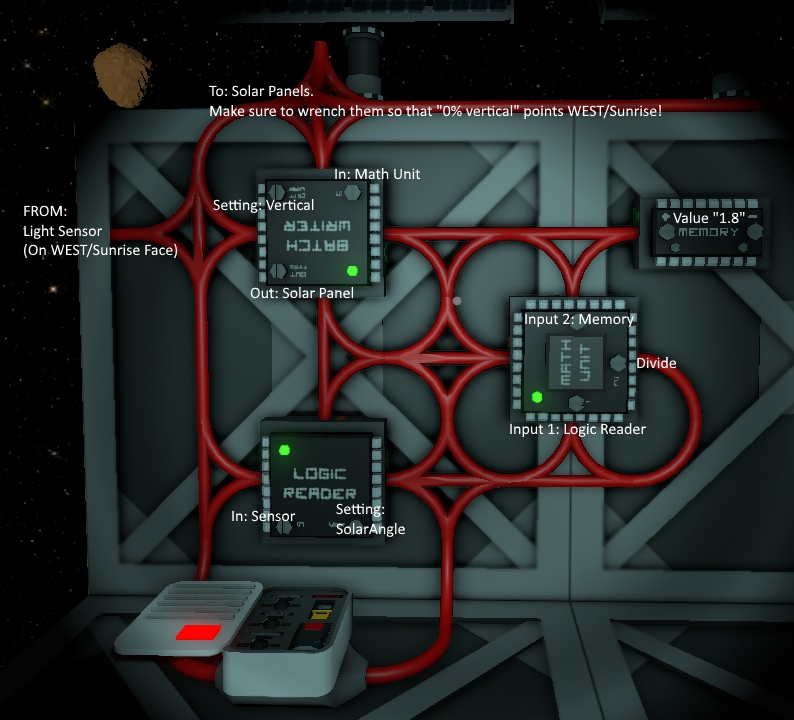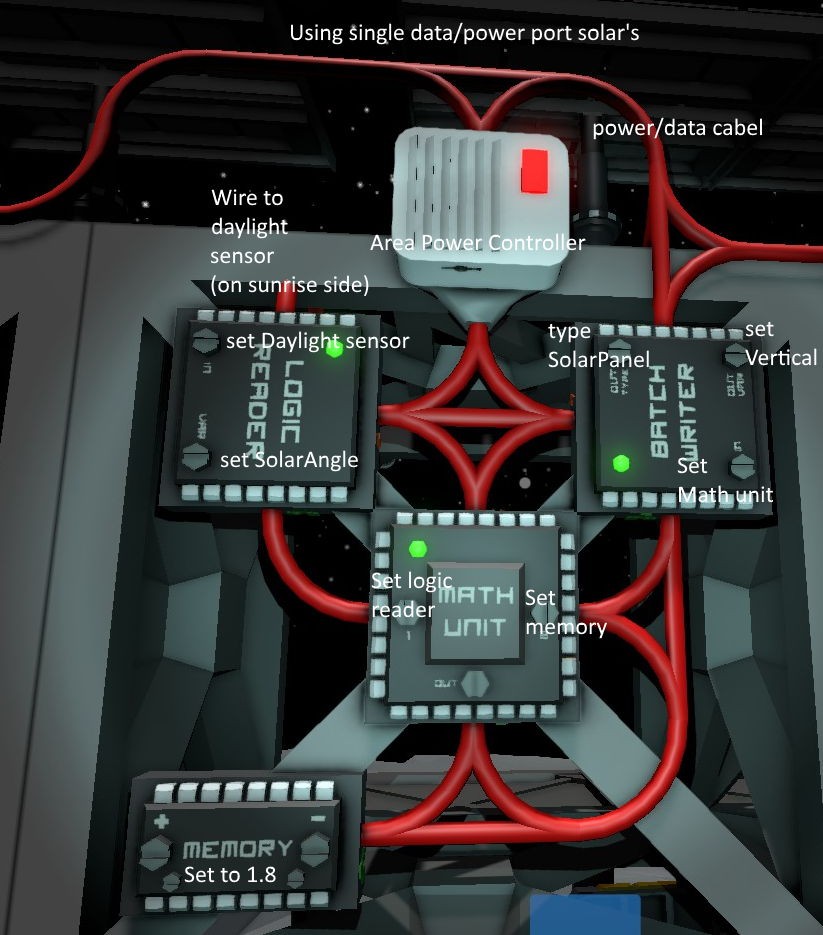Difference between revisions of "Solar Logic Circuits Guide"
From Unofficial Stationeers Wiki
Enthalpy Guy (talk | contribs) m (→Ecliptic Solar Tracking) |
Enthalpy Guy (talk | contribs) m (Updated version, component count and authors) |
||
| Line 9: | Line 9: | ||
== Ecliptic Solar Tracking == | == Ecliptic Solar Tracking == | ||
'''Author:''' Eearslya, Neouni, 𝕽𝖘𝖆𝟗𝟕 and everyone of the #logic-circuit-discussion (most recently Enthaply Guy)<br> | '''Author:''' Eearslya, Neouni, 𝕽𝖘𝖆𝟗𝟕 and everyone of the #logic-circuit-discussion (most recently Enthaply Guy)<br> | ||
| − | '''Stationeers Version:''' 0. | + | '''Stationeers Version:''' 0.2.2261.10316 and up<br> |
| − | '''Number of Components:''' | + | '''Number of Components:''' 12 |
=== Design === | === Design === | ||
Revision as of 14:49, 4 January 2020
Contents
Disclaimer
Due to the frequency of game updates, all solutions are subject to change and may or may not be functional.
Ecliptic Solar Tracking
Author: Eearslya, Neouni, 𝕽𝖘𝖆𝟗𝟕 and everyone of the #logic-circuit-discussion (most recently Enthaply Guy)
Stationeers Version: 0.2.2261.10316 and up
Number of Components: 12
Design
- 2 Kit (Sensors)
- 4 Kit (Logic I/O)
- 3 Kit (Logic Memory)
- 3 Kit (Logic Processor) ("Math Unit")
This is a fairly minimalistic 2-axis control setup. You'll need the sensors to be in Mode 1 (horizontal) and Mode 2 (vertical), both facing up. The cable can point in any direction, as the vertical sensor doesn't care and we're already compensating for the horizontal sensor.
To set the sensors, you will need to use a Logic Writer and a Logic Memory. Set the memory to 1, and set the writer to write to the first sensor's Mode variable. Then set the Writer to write to the second Sensor, and set the memory to 2 (in that order!). The sensors should say "Mode Horizontal" and "Mode Vertical". Once you have them set, you can deconstruct and re-use the I/O and memory units. They do not need to be left in place to keep the mode set.
Notes
- Network 1 should have a steady source of power. Ideally, an APC that's fed by the solar panels.
- Network 2 is connected to Logic A and E input, and Logic D and J outputs. It needs to hold solar panel power/data ports and both daylight sensors.
- Logic A (reader) reads SolarAngle from daylight sensor in Horizontal mode.
- Logic B (math unit) subtracts Logic A from Logic C. Note that it must be upside down!
- Logic C (memory) should be one of 90, 180, 270 or 360. We're using it to compensate for horizontal sensor orientation. If the sensor cable points the same direction as the solar panels power port, set it to 90. Add 90 for every rotation counterclockwise.
- Logic D (batch writer) reads from Logic B, and writes to Horizontal field for all Solar Panels.
- Logic E (reader) reads SolarAngle from the sensor in Vertical mode.
- Logic F (math unit) divides Logic E by Logic G.
- Logic G (memory) is set to 1.5. It's used to scale from 180° that the sensor reports to the 100% that the solar panels use.
- Logic H (math unit) subtracts Logic F from Logic I. Note that the right input must be Logic F, and the left input must be Logic I!
- Logic I (memory) is set to 50. The vertical reader reports 0° at midday and 90° at sunrise/sunset, but we need the panels to be at 50% at midday and 0% at sunrise/sunset.
- Logic J (batch writer) reads from Logic H and writes to Vertical field for all Solar Panels.
Credit for alternatives: PoolSharkFOG
This setup can be also programmed in an IC10 chip which saves power because you need only 5 chips instead of 8.
Required:
1 IC10 Chip plus IC housing
2 sensors setup as shown above
2 memory
2 Batch Writers that read from memory
Connect Sensor1 to d0, Sensor2 to d1, Memory1 to d2, Memory2 to d3.
BatchWriter Horizontal should read from Memory1 and BatchWriter Vertical should read from Memory2 and both ofcourse write to the solar panels.
Use the same setup for the power connector directions as shown above. You do not have to write the mode, this is done in code.
Here is the code for the ic10 chip: Simulator @ stationeering.com
Accurate Solar Setup
Authors: Wooodiii, Corvus_bkgk, Enfantcool, Baksch
Properties: Accurate (average error 1.3°), Auto-reset (variant), Power conserving (variant)
Number of Components: 10-12
Math Formula: f(x) = min((x-min(x,15))/1.5, 100) where x is the solar angle.
Note: With the introduction of ecliptic solar angles, this setup no longer works at peak efficiency on worlds such as Mars and Europa which have the sun at an angle. This setup will still work on the Moon and in Space.
This setup is accurate, giving 495-500W throughout the day, with lower output only when the sun is lower than the panels can physically aim at.
This setup adjusts for the fact that solar panels rotate through only 150 degrees. Instead of converting using 180/100, this setup converts by doing 150/100. It then clips the value at the edges, where the prior calculation would give elevations that are negative or greater than 100 (representing the fact that we would prefer the panel to track past 0 or 100, aiming all the way down to the horizon instead of stopping 15° short). The listed average error is nonzero only because of this completely unavoidable portion; the error is 0 throughout the 15°-165° portion of the day.
This setup produces the equivalent of 274W averaged over a whole day/night cycle.
Link to IC Programm : [1]
Design
- 1 Kit (Sensors) ("Daylight Sensor")
- 2 Kit (Logic I/O) (1 "Logic Reader", 1 "Batch Writer")
- 3 Kit (Logic Memory)
- 4 Kit (Logic Processor) (2 "Math Unit", 2 "Min/Max Unit")
- The Daylight Sensor should face the sunrise.
- Solar panels should be rotated such that 0% vertical faces the sunrise.
| Component (Name) | Settings | Explanation |
|---|---|---|
| Logic Reader (A) | Daylight sensor, Solar angle | Sun's angle above the horizon |
| Memory (15) | 15 | True angle of solar panels at 0 elevation |
| Memory (1.5) | 1.5 | 150/100, the conversion constant from solar angle (range:15-165, i.e. 150) to panel elevation (range:0-100) |
| Min/Max Unit (B) | min(A,15) | Adjustment amount: 15, unless that would take A-B negative, in which case only enough to reach 0 (low edge case). Equivalent to min(A-B,0) but doesn't require storing 0. |
| Math Unit (C) | A-B | Adjusted solar angle |
| Math Unit (D) | C/1.5 | Conversion from solar angle to panel elevation |
| Memory (100) | 100 | Maximum possible panel elevation |
| Min/Max Unit (E) | min(D,100) | Cap elevation to 100 for solar angles past 165° (high edge case). Equivalent to doing min(A-B,165) before step D, but 100 is easier to set in memory than 165. |
| Batch Writer | E -> Solar panels, Vertical angle | Send elevation to solar panels |
Auto-Reset Variant
For panels that automatically reset their facing upon sunset, use two more components, and adjust the final min/max unit:
| Component (Name) | Settings | Explanation |
|---|---|---|
| Logic Reader (L) | Daylight sensor, Activation | 1 while daytime, 0 while nighttime |
| Math Unit (F) | 100*L | Maximum panel elevation, now 100 during day and 0 at night |
| (from above) Min/Max Unit (E) | min(D,F) | Adjusted panel elevation (high edge adjustment) |
Power-Conserving Variant
To conserve power, it's possible to avoid running the entire circuit at night. A transformer can be controlled to power the main logic network above. In this way, only the two new components need to remain powered at all times.
| Component (Name) | Settings | Explanation |
|---|---|---|
| Logic Reader (L) | Daylight sensor, Activation | As in the auto-reset variant above |
| Logic Writer | L -> Transformer, On | Transformer powers main logic network |
Easy/Compact Solar Setup
Author: Evie
Stationeers Version: 0.1.1068.5451
Properties: Simple, Inaccurate (Average error: 7.5°)
Number of Components: 5
Note: With the introduction of ecliptic solar angles, this setup no longer works at peak efficiency on worlds such as Mars and Europa which have the sun at an angle. This setup will still work on the Moon and in Space.
This imperfect setup is a common starting point. It starts off at 375w of power in the morning, builds up to 500w at zenith (noon) then back to 375. This is due to the fact that solars rotate through only 150 degrees of elevation and that this setup's math is correct only if they rotated through all 180 degrees of solar angle.
This setup produces the equivalent of 239W averaged over a whole day/night cycle.
Design
- 1 Kit (Sensors)
- 2 Kit (Logic I/O)
- 1 Kit (Logic Memory)
- 1 Kit (Logic Processor) ("Math Unit")
Notes
- The Daylight Sensor MUST be facing East (Sunrise), but its rotation doesn't matter.
- Solar panels should be rotated such as that 0% VERTICAL rotation faces East/Sunrise, and 100% VERTICAL faces West/Sunset.
- The Area Power Control is necessary for the circuit to stay powered during the night. It also hides all the modules from the rest of your system.
- Importantly, the solar input power doesn't directly connect to any of the logic writers. This not only ensures your system doesn't lose power but also prevents short-circuiting that would burn cables.
- Using 1.7 instead of 1.8 reduces the average error of this design to 6.5° and increases overall power generation, particularly in the afternoon.




